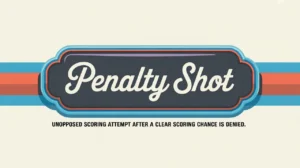Jim’s Intro to Faceoff Circles & Dots
Hi folks, Jim here, the only commentator who once lined up for a ceremonial faceoff, but then realized I was meant to be at the rink and not at a “bring-your-own-mask” birthday party.
What are faceoff circles and dots?
Faceoff circles and dots are the fixed reference points where play starts and restarts. There are nine dots on the ice: one at center ice, two in each team’s defensive zone, and four in the neutral zone. Each dot has a surrounding circle except the neutral zone dots, which only have markings for positioning. These spots structure the flow of the game, dictate where teams line up, and create tactical opportunities off the drop of the puck.
- Center Dot: Used for period starts and after every goal.
- End Zone Dots: Located in the offensive and defensive zones, used for most stoppages in play.
- Neutral Zone Dots: Used for offsides and some neutral zone faceoffs.
The circles ensure players line up consistently and stay outside the designated area until the puck is dropped.
How do they work?
Faceoff circles and dots shape possession, positioning, and momentum.
- Referee Drop: The puck is dropped at a dot to restart play. Players line up according to strict rules about stick placement, feet positioning, and encroachment.
- Offensive Opportunities: In the offensive zone, winning a clean draw can set up immediate shots, point plays, or controlled cycles.
- Defensive Reads: Defenders use faceoffs to gain quick possession and clear pressure.
- Set Plays: Teams design specific faceoff strategies based on which dot the play starts at, whether it’s a quick shot from the point, a backdoor pass, or a regroup.
- Positional Structure: The circles keep players spread and organized, creating predictability for both teams.
How do you make good decisions with them?
Winning faceoffs starts with technique and awareness.
- Choose Your Grip and Stance: Centers use different hand positions and body angles to gain leverage.
- Read the Opponent: Anticipate forehand or backhand draws and counter accordingly.
- Support Players: Wingers and defensemen must be ready to pounce on loose pucks or block opposing players immediately.
- Know the Dot: Each faceoff location has unique angles and opportunities. Offensive zone draws might aim for quick shots, defensive ones for clean exits.
- Avoid Encroachment: Entering the circle early or lifting an opponent’s stick illegally can lead to ejections or penalties.
How do you master them?
Mastering faceoffs takes repetition, timing, and strategy. Skilled centers study their opponents’ habits and vary their own techniques. Teams practice set plays for each faceoff dot, rehearsing puck movement and positioning. Support players learn to react instantly once the puck hits the ice, turning a little advantage into possession and control.
What does it look like when done right?
A clean, well-executed faceoff looks like a choreographed play. The center wins the draw with precision, support players move decisively, and the puck flows smoothly into a set play. On defense, players seal off lanes, clear the zone quickly, or shut down offensive setups before they start.
Commentator’s Corner
Jim’s Take
I’ve seen more goals in the first two seconds after a clean offensive draw than on some entire power plays. A good faceoff is like hitting the gas pedal on a set play.
Parent Tip
Encourage young players to take faceoffs seriously. Learning timing, technique, and positioning early pays huge dividends later.
Player Tip
Work on your reaction time and stick strength. The best faceoff players don’t just win with speed, they win with craft and consistency.
A Final Thought
Faceoff circles and dots are where possession is decided and momentum is set. Master the drop, and you can tilt the ice in your team’s favor every shift.









